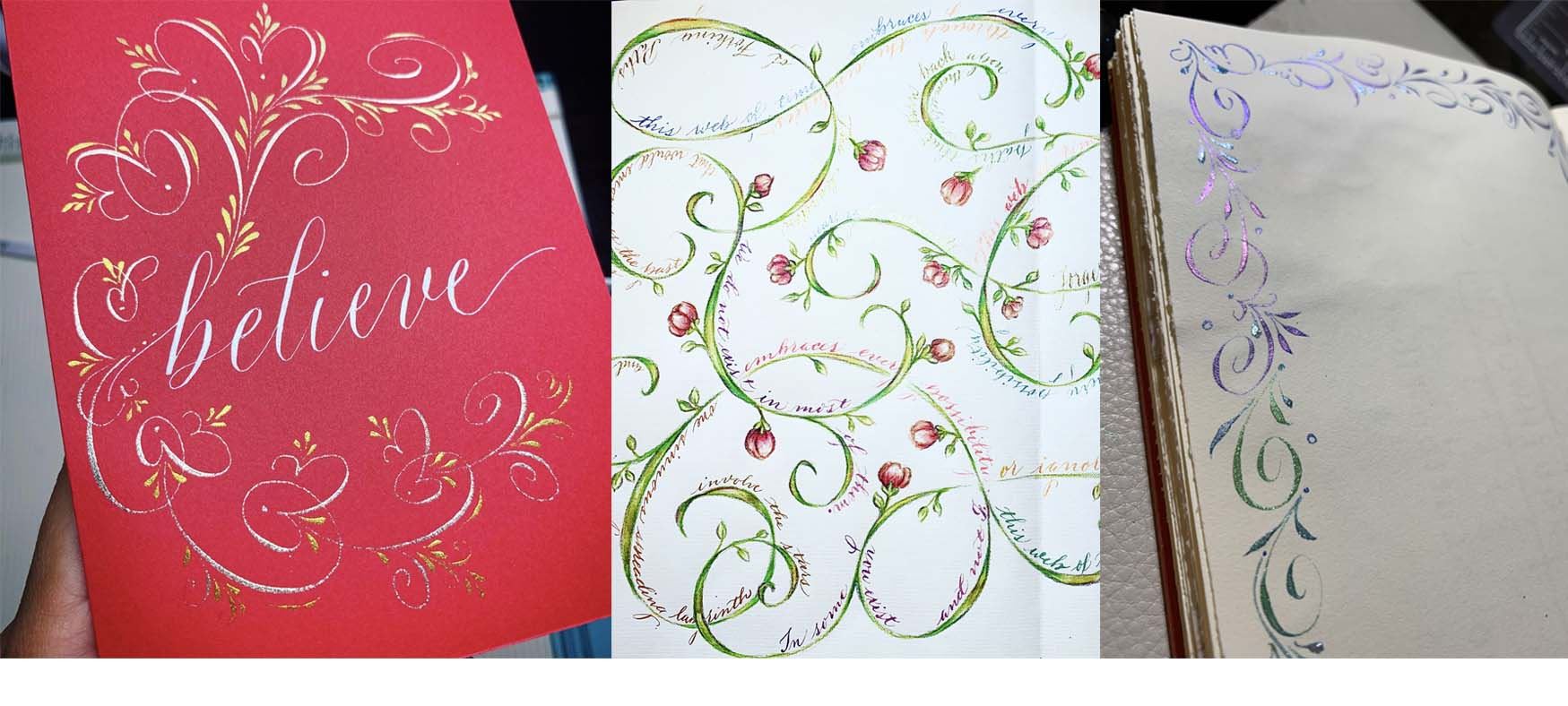Presenter: Michelle Morin
 SPONSORED: Inland Empire/Pomona Valley Chapter
SPONSORED: Inland Empire/Pomona Valley Chapter
ABOUT THE PROGRAM: In this class, we will use both composition principles and intuition (improvisation) to make fun and beautiful modern flourished borders for your calligraphy or handwritten pieces. Michelle will use a pointed pen with metallic watercolors, but you may use any tool and any ink you prefer (see materials list for suggested alternative monoline or pressure-sensitive tools).
These borders can coordinate with many calligraphic hands, including Copperplate-based and Spencerian-based pointed pen scripts. Michelle has used these borders around and in her calligraphy sketchbook pages and art pieces, on cards, and as custom stationary borders.
Experience with preparing and using a pointed pen is recommended but not required if other tools are used.
In this class, we will learn:
- How to make easy shapes that become the components of a modern flourished border
- How to combine those shapes as you move along the page border, in either an intuitive process or through intentional planning and, if you wish, a grid system
- How to vary the shapes and styles to create different looks, using metallic watercolors, watercolor pencils, and/or different types of pointed nibs
ABOUT MIMO: Michelle Morin ("Mi Mo") enjoys learning and creating in many visual arts and calligraphic traditions, including mixed-media, watercolor, and hand bookbinding, as well as calligraphy and lettering using pointed pen, pointed brush/marker, pencil, and other tools. Mi Mo teaches a Copperplate-based Modern Calligraphy and runs regular calligraphy study groups and creative meetups online. She is also a collector of fountain pens, hoarder of art supplies, avid journal-keeper and journal-maker, Program Chair for Pacific Scribes, corporate lawyer, and mom. @michelle.l.mo and @calligra_mi.
SUPPLIES:
Your favorite pointed pen holder (straight or oblique), at least two different pointed nibs, ink, preferably in a few colors, and paper of your choice that works well with your inks and nibs.
These are the nibs, inks, and paper I like. You do not have to buy exactly what I use! Use what you have and what you love:
- Nibs: a softer nib such as a Hunt 101; a slightly firmer nib such as a vintage Gillott 404 and/or a Nikko G or Zebra G might be fun to try as well.
- Inks: I will be using half-pans, quarter pans, or sample “dots” of metallic watercolors (i.e., rewetting dry watercolors and painting them onto the nib). My current favorite makers are:
- Shipped from US (find online or on Etsy): Cloverset Lettering (she rotates colors often and I love her sample dots because they are bigger than average); Iuile Watercolors; Tiny Cactus Designs; Coliro Finetec.
- Ships from outside the US, so availability/shipping time may be an issue: The Creative Kinds, And Flower Tales. (both on Etsy)
- Paper:
- For class practice, anything that works with your pointed pens and watercolor pencils. Marker paper such as Canson XL or Borden & Riley #37 Boris Marker Layout will work for the pointed pens.
- Crane’s Lettra, which is a yummy but expensive 100% cotton paper with a bit of tooth, is great for this type of watercolor pencil work and also works for pointed pen, though your nib may catch on the fibers.
- Southworth 100% Cotton resume paper (in white or ivory, in 24 or 32 lb) is a bit smoother than Crane’s Lettra.
- Tomoe River (extremely lightweight, smooth, 52 gsm Japanese stationery paper) is very good for writing with pens and fountain pens. It works with pointed pen and I love writing letters with it.
- Watercolor pencils and a fine-point waterbrush, such as the Pentel Aquash or similar. (Or simply use a soft-graphite pencil!)
- I suggest having a selection of warm and cool reds or pinks, warm and cool greens, a few blues and purples, a yellow, and any other colors you like. For example, in Derwent Inktense I like Fuchsia, Poppy Red, Apple Green, Teal Green, Peacock Blue, and Mustard. You could buy singles from your local art store or dickblick.com if you want to try them out.
- I suggest a good artists’ quality brand, such as Derwent Inktense or Faber-Castell Albrecht Durer watercolor pencils, because rewetting the pigment with the waterbrush will have more impact.
PROGRAM IS FULL. REGISTRATION IS CLOSED